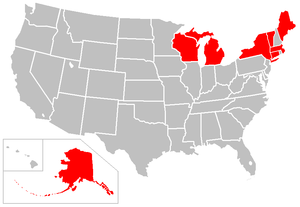- Cryoseism
-
A cryoseism, also known as a frost quake[1][2], may be caused by a sudden cracking action in frozen soil or rock saturated with water or ice.[3] As water seeps down into the rock, it freezes and expands, putting stress on surrounding rock. This builds up until it is relieved explosively in a cryoseism.[4]
Another form of cryoseism known as an ice quake, is a non-tectonic seismic event caused by sudden glacial movements, sometimes due to the formation of a thin veneer of liquid water under a glacier from surface melting. Usually, a glacier would stick to the rough bedrock, but the hydraulic pressure acts as a lubricant, allowing it to slide up to many metres at once.[5][6] This type of cryoseism can last for tens of minutes.[7]
As the requirements for cryoseisms to occur are not yet defined, their prediction is still not possible and constitute a significant factor in structural design and engineering.[3] Links have been made between global warming and the frequency of cryoseisms.[7]
Contents
Effects
Cryoseisms are often mistaken for minor or intraplate earthquakes.[3][8] Although the outward signs often appear similar to those of an earthquake, with tremors, vibrations, ground cracking and related noises[2] such as thundering or booming sounds,[4] cryoseisms can be distinguished from earthquakes through meteorological and geological conditions.[3] Cryoseisms can have an intensity of up to VI on the Modified Mercalli Scale.[3] Furthermore, cryoseisms often exhibit high intensity in a very localized area,[2] in the immediate proximity of the epicenter,[8] as compared to the widespread effects of an earthquake.[3] Due to lower frequency vibrations than earthquakes,[5] some seismic monitoring stations may not record their occurrence.[8] Although cryoseisms release less energy than most tectonic events,[9] they can still cause damage or significant effects at the site.[2]
Some reports have indicated the presence of "distant flashing lights" before or during a cryoseism, possibly due to the electrical changes when the rocks are compressed.[4] Cracks and fissures can also appear, as the ground may contract and split apart from the cold.[2][8] These, usually superficial, cracks range from several centimetres to several kilometres long, with either a single linear fracture or multiple ones as well as small vertical and moderate lateral displacement.[3]
An ice quake prevented Walter Wellman and his team from venturing to the north pole in 1898.[10]
Occurrences
Location
Geocryological processes were identified as the cause of tremors as early as 1818.[3] In the United States, such events have been reported in the states of Connecticut,[2] Maine,[2] Massachusetts,[2] Michigan[2], Indiana, Ohio[11] upstate New York,[2] Vermont[2][8] and Wisconsin,[1] all in the Northern and Northeastern United States.[4] Cryoseisms have also surfaced in Ontario, Canada.[12] Also, glacier-related phenomena have been reported in Greenland,[13] Alaska,[14] the Antarctic Prince Charles Mountains[15] and Ross Island,[9] and Iceland (Grímsvötn).[16]
Precursors
Cryoseisms typically occur when temperatures rapidly decrease from above freezing to subzero, in the first cold snap of spring.[2][8] They usually occur between midnight and dawn, during the coldest part of the night.[3] However, glacier-related cryoseisms may occur in the warmer months of summer, due to the permanent nature of glacial ice.[5] In general, cryoseisms occur 3 to 4 hours after significant changes in temperature.[17] Due to the perennial or seasonal frost conditions involved with cryoseisms, these events are limited to temperate climates which experience seasonal variation with subzero winters. Furthermore, the ground must be saturated with water, which can be caused by snowmelt, rain, sleet or flooding[3] and the site of a cryoseism generally has little or no snow cover to insulate the ground.[2][3] Geologically, areas of permeable materials like sand or gravel, which are affected by frost action are most susceptible to experience cryoseisms.[3] After large cryoseisms, there is generally no seismic activity detected for several hours, an indication that accumulated stress has been relieved.[17]
See also
References
- ^ a b "Milwaukee Area Frostquakes". University of Wisconsin–Milwaukee. 1994-02-24. http://www.uwm.edu/Dept/Geosciences/qketour/frostqke/cryoseis.html. Retrieved 2006-10-22.
- ^ a b c d e f g h i j k l m "Cryoseisms in Maine". Maine Geological Survey, the State of Maine. 2005-10-06. http://www.maine.gov/doc/nrimc/mgs/explore/hazards/quake/quake-cryoseism.htm. Retrieved 2006-10-21.
- ^ a b c d e f g h i j k l Andrew V. Lacroix (January 1980). "A Short Note on Cryoseisms". Earthquake Notes. http://www.uwm.edu/Dept/Geosciences/qketour/frostqke/lacroix.html. Retrieved 2006-10-21.
- ^ a b c d Dave Thurlow. "Cryoseisms Explained". The Weather Notebook. Mount Washington Observatory. http://weathernotebook.org/transcripts/2000/04/14.html. Retrieved 2006-10-21.
- ^ a b c William Orem (2004-09-14). "Ice Quake!". A Moment of Science. Indiana University. http://amos.indiana.edu/library/scripts/icequake.html. Retrieved 2006-11-16.
- ^ Sylvia S. Tognetti (2006-03-27). "Climate and economic models". The Post-Normal Times. http://www.postnormaltimes.net/blog/archives/2006/03/climate_and_eco.html. Retrieved 2006-11-16.
- ^ a b Tom Irvine (June 2006). "Ice Quakes" (.pdf). Vibrationdata Newsletter. http://www.vibrationdata.com/Newsletters/June2006_NL.pdf. Retrieved 2006-11-16.
- ^ a b c d e f John E. Ebel, Richard Bedell & Alfredo Urzua (July 1995). "A Report on the Seismic Vulnerability of the State of Vermont". Geology of Mineral Resources. Vermont Geological Survey. http://www.anr.state.vt.us/dec/geo/EBEL.htm. Retrieved 2006-10-22.
- ^ a b "Erebus Icequakes". Mount Erebus Volcano Observatory. Archived from the original on 2006-08-31. http://web.archive.org/web/20060831112521/http://www.ees.nmt.edu/Geop/mevo/seismic/icequakes.html. Retrieved 2006-11-16.
- ^ "Arctic Postal History: The Wellman Expedition". 2004. http://www.south-pole.com/aspp008.htm. Retrieved 2006-11-16.
- ^ Prof. Kazuya Fujita (2000-10-25). "Seismic Events in Michigan - Explosions and Other Events". Michigan State University. http://www.msu.edu/~fujita/earthquake/mievents.html. Retrieved 2006-10-22.
- ^ "Frequently Asked Questions about Earthquakes". Natural Resources Canada. 2006-05-08. http://earthquakescanada.nrcan.gc.ca/gen_info/faq_e.php. Retrieved 2006-10-26.
- ^ "Гренландские ледники трещат по швам" (in Russian). Bigli Facts. Bigli Web. http://facts.bigli.ru/2/fact-348/. Retrieved 2006-10-22.
- ^ "Alaska Glacier Tours - Know What To Look For". Alaska Channel. http://www.alaska.org/glaciers/advice-know-what-to-look.htm. Retrieved 2006-11-16.
- ^ Nicole Johnston (2002-11-29). "Surveying the Icy Peaks". Antarctic Summer (ABC News). http://abc.net.au/news/specials/antarcticsummer/stories/pcmega.htm. Retrieved 2006-11-16.[dead link]
- ^ "The Icelandic "Icy Flood"". ThinkQuest Library. October 2003. http://library.thinkquest.org/03oct/00421/izland_k_eng.htm. Retrieved 2006-11-16.
- ^ a b D.E. Willis, R.W. Taylor, M. LeNoble, & S. Yellin (October 1979). "Icequake Precursors". 51st Annual Meeting of the Eastern Section of the Seismological Society of America. Dept of Geological Sciences, University of Wisconsin–Milwaukee. http://www.uwm.edu/Dept/Geosciences/qketour/frostqke/willis2.html. Retrieved 2006-11-16.
Categories:- Geological hazards
- Weather hazards
- Seismology and earthquake terminology
Wikimedia Foundation. 2010.

